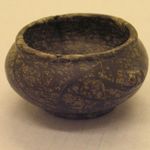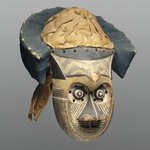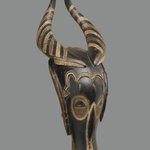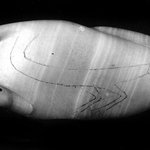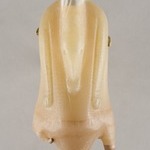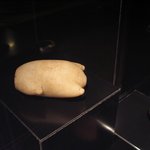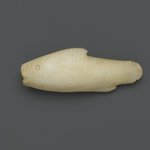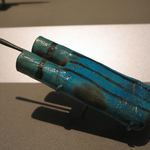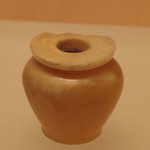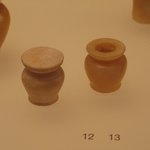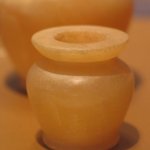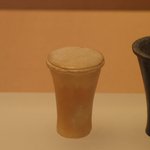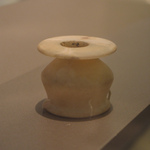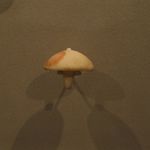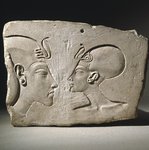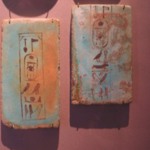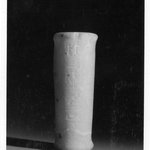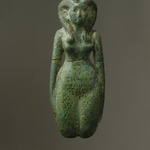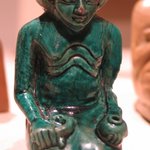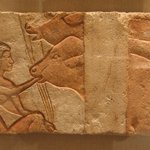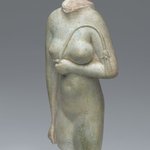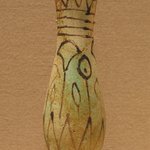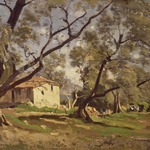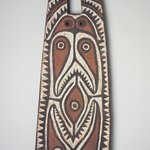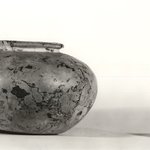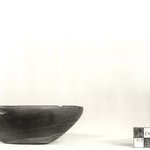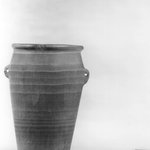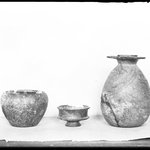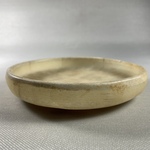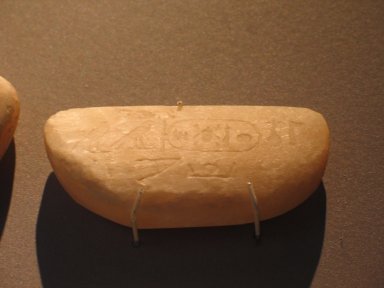
Model Grinder Inscribed for Amunhotep II
Egyptian, Classical, Ancient Near Eastern Art
Foundation Deposits
In addition to commissioning new buildings, Egyptian kings occasionally claimed existing structures such as temples or palaces as their own.
The most common way for a king to do this was to substitute his own name for that of the original builder in the inscriptions. When a king commissioned a new structure, he buried objects in the four corners of the foundation to be certain that the gods would remember the true builder and that later kings could not find and reinscribe them. These so-called foundation deposits usually included plaques with the king’s name, as well as models of objects used to erect the building, such as grinders, hoes, and rockers needed to move large stones.
In addition to commissioning new buildings, Egyptian kings occasionally claimed existing structures such as temples or palaces as their own.
The most common way for a king to do this was to substitute his own name for that of the original builder in the inscriptions. When a king commissioned a new structure, he buried objects in the four corners of the foundation to be certain that the gods would remember the true builder and that later kings could not find and reinscribe them. These so-called foundation deposits usually included plaques with the king’s name, as well as models of objects used to erect the building, such as grinders, hoes, and rockers needed to move large stones.
MEDIUM
Egyptian alabaster
DATES
ca. 1426–1400 B.C.E.
DYNASTY
Dynasty 18
PERIOD
New Kingdom
DIMENSIONS
Other (average): 1 9/16 x 3 9/16 in. (4 x 9 cm) (show scale)



COLLECTIONS
Egyptian, Classical, Ancient Near Eastern Art
ACCESSION NUMBER
36.621.2
CREDIT LINE
Charles Edwin Wilbour Fund
PROVENANCE
Archaeological provenance not yet documented, probably excavated by the Egyptian Antiquities Service at the Temple of Amenophis II, near the Great Sphinx, Giza, Egypt; by 1936, acquired by Louis Herse of Alexandria, Egypt; 1936, purchased from Louis Herse by the Brooklyn Museum.
Provenance FAQ
CATALOGUE DESCRIPTION
[One of] 3 stones of unknown use from the foundation deposit, 2 of alabaster, crescent shape, one of green stone and mound shape each bearing incised carotuches of Amenhotep II.
Condition: Good.
EXHIBITIONS
MUSEUM LOCATION
This item is not on view
CAPTION
Model Grinder Inscribed for Amunhotep II, ca. 1426–1400 B.C.E. Egyptian alabaster, Other (average): 1 9/16 x 3 9/16 in. (4 x 9 cm). Brooklyn Museum, Charles Edwin Wilbour Fund, 36.621.2. Creative Commons-BY (Photo: Brooklyn Museum, CUR.36.621.2_erg456.jpg)
IMAGE
overall, CUR.36.621.2_erg456.jpg. Brooklyn Museum photograph, 9/6/2007
"CUR" at the beginning of an image file name means that the image was created by a curatorial staff member. These study images may be digital point-and-shoot photographs, when we don\'t yet have high-quality studio photography, or they may be scans of older negatives, slides, or photographic prints, providing historical documentation of the object.
RIGHTS STATEMENT
Creative Commons-BY
You may download and use Brooklyn Museum images of this three-dimensional work in accordance with a Creative Commons license. Fair use, as understood under the United States Copyright Act, may also apply.
Please include caption information from this page and credit the Brooklyn Museum. If you need a high resolution file, please fill out our online application form (charges apply).
For further information about copyright, we recommend resources at the United States Library of Congress, Cornell University, Copyright and Cultural Institutions: Guidelines for U.S. Libraries, Archives, and Museums, and Copyright Watch.
For more information about the Museum's rights project, including how rights types are assigned, please see our blog posts on copyright.
If you have any information regarding this work and rights to it, please contact copyright@brooklynmuseum.org.
RECORD COMPLETENESS
Not every record you will find here is complete. More information is available for some works than for others, and some entries have been updated more recently. Records are frequently reviewed and revised, and we welcome any additional information you might have.


